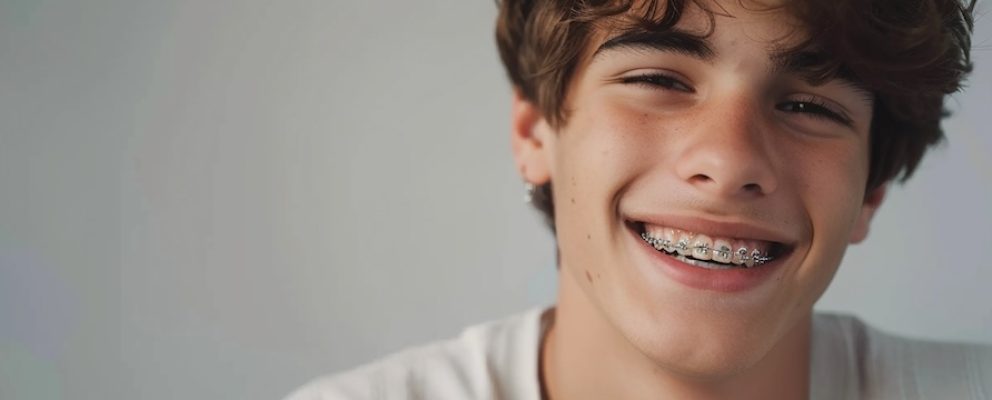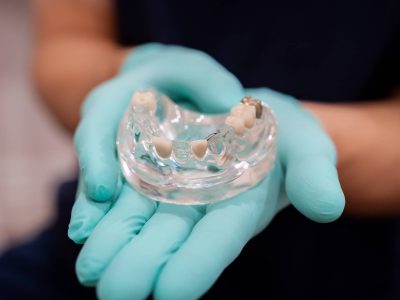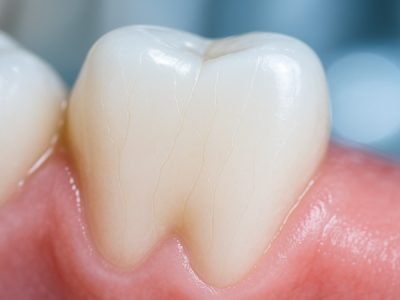Food is one of the top concerns when I discuss braces with clients. “What can’t I eat with braces?” is often the first question I hear. Fortunately, there is a wide range of food you can safely eat with braces, including mashed potatoes, smoothies, bananas, and scrambled eggs.
In this guide to brace-friendly foods, I’ll cover tips for chewing with braces, the best foods for braces, and foods to avoid with braces.
Why Your Food Choices Matter
This is a common and important question. The wrong foods can damage brackets and wires or cause unnecessary pain.
It is important to avoid hard, chewy, tough, and sticky foods to protect your mouth and braces.
Learn more about tips for braces and chewing with braces here: What You Need to Know About Braces.
What Can’t I Eat with Braces?
If you’re wondering, “What can’t I eat with braces?”, this section is for you.
Here is a list of foods I do not recommend eating with braces:
- Hard foods, such as nuts and crusty bread
- Raw vegetables, such as carrot and celery sticks
- Sticky candies, such as chewy lollies, taffy, jellybeans, or gummy bears
- Hardy candy, such as peanut brittle
- Crunchy snacks, such as popcorn or chips
- Foods you have to bite into, such as corn on the cob and apples
- Dried fruit
- Caramel
- Gum
- Non-food objects, such as ice cubes or pens
- Any other hard or sticky foods
What Foods Can I Eat with Braces?
Braces-Safe Food List
Here are my top recommendations for brace-friendly foods:
- Smoothies: Smoothies are my top recommendations for the best food to eat with braces. They are delicious, healthy, and safe to eat with braces. Smoothies are easy to consume and if you blend in some frozen fruit, they can be incredibly soothing on sore teeth and gums. They are also versatile and easy to customise. I like blending leafy greens, yoghurt, hemp seeds, and frozen raspberries for an easy, healthy breakfast or snack.
- Soups: Soup is another top choice for braces-safe food. Tomato soup is an excellent option as it is nutrient-dense and easy to eat. Other options include cream of chicken, cream of mushroom, or blended chicken noodle soup.
- Mashed Potatoes: Mashed potatoes are the perfect comfort food when you’re craving something more substantial. With their creamy, soft texture, mashed potatoes are ideal for teeth that are tender from braces or aligners.
- Bananas: Bananas are rich in vitamins and minerals while being gentle on sore teeth. If your teeth are particularly tender, opt for a very ripe banana.
- Applesauce: Applesauce is a classic brace-friendly food. This naturally sweet choice makes a great side, snack, or even a healthy dessert.
- Scrambled Eggs: If you need a high-protein food that is safe for braces, scrambled eggs are a great option. Scrambled eggs are soft and easy to chew while being nutrient-dense.
- Ice Cream: I can tell you without a doubt that my patients would all agree that ice cream is the best food for braces! Between its soft, creamy texture and cold temperature, ice cream is delicious and soothing on sore teeth. Bonus: Ice cream’s cold temperature can help reduce swelling and tenderness. Still, don’t go overboard on ice cream due to its high sugar content.
- Soft Cheeses and Yoghurt: Similar to ice cream, soft cheeses and yoghurt offer a creamy texture and soothing coolness. For the healthiest option, look for brands with no to low added sugar.
- Fish: Steak, chicken, and pork can be too tough to chew with new braces or sore teeth. With a flaky, tender texture, fish is an excellent option. Baked, steamed, or boiled is the best prep method for tender teeth.
- Cooked Vegetables: Raw veggies, such as carrot sticks or celery, are a no-go with braces. Baked, steamed, or boiled vegetables can be a healthy option, though. I recommend asparagus, broccoli, steamed greens, and squash as nutrient-dense options that cook up nice and soft.
- Pasta: Well-cooked pasta is a filling, brace-friendly food option.
Tips for Soft Meal Planning for Braces
Here are the tips I give my patients for soft meal planning for braces:
- Focus on ensuring you still get enough fruits and veggies in your diet
- Get creative with add-ins. For instance, top scrambled eggs with salsa, sour cream, and cilantro. Or, add butter and dried parsley to mashed potatoes. Soft foods do not have to be flavourless or boring!
- Make sure your meals include some form of protein
- If you want to enjoy bread with your soup, soften it up in the broth beforehand for easier chewing with braces
- Aim for a balanced diet that features a variety of foods
- Prioritise whole foods
- Smoothies are my favourite option for getting a ton of nutrition without even needing to chew or worry about tender teeth
I go into more depth on eating with braces in my guide here: How to Eat Comfortably with Braces.
Chewing with Braces – What to Know
What to Expect when Chewing with Braces
Chewing with braces takes some getting used to. It is the most uncomfortable when you first get braces, have your brackets tightened, or switch to a new set of aligners.
You may notice your teeth fit together a bit differently than before. This can make it feel slightly awkward to chew. Always take your time to ensure you do not accidentally bite the inside of your cheeks or lips.
If your are experiencing a lot of discomfort or tenderness, ask your dentist about over-the-counter pain relievers.
Tips for Reducing Discomfort and Avoiding Damage
If you just got braces, had an adjustment, or switched to your next set of aligners, I recommend soft or liquid foods for the first 24 to 48 hours.
Here are my other tips for chewing with braces and avoiding damage:
- Opt for soft or blended foods
- Choose cold foods as they can be soothing and ease swelling
- Take your time chewing and take small bites
- Avoid sticky and hard foods
- Cut food into small pieces
- For foods like corn on the cob, cut the kernels off the cob
- Try to use your back teeth for chewing
Can I Chew Gum with Braces?
When I tell a patient they need braces, I can almost always count on them asking, “Can I chew gum with braces?”.
No, I do not recommend chewing gum with braces. Gum’s sticky texture can cause damage to brace hardware, such as brackets and wires.
Sugar-free mints and breath spray can provide a good alternative to chewing gum with braces.
Eating on the Go – School, Work, and Dining Out
Portable lunchbox ideas for braces include:
- Applesauce
- Bananas are the best grab-and-go food that is safe for braces
- Soups in a thermos
- Berries
- Cooked squash or sweet potatoes
- Yoghurt
- Soft cheese
- Jello or pudding (watch the sugar content)
- Smoothies travel well and make a great grab-and-go breakfast
What to Avoid when Eating Out with Braces
When eating out, avoid ordering hard, tough, or chewy foods, such as steak or corn on the cob. Focus on soft, easy-to-chew foods that are gentle on teeth and your braces.
Here’s a healthy meal suggestion if you need to order at a restaurant with braces:
- Steamed fish
- Mashed potatoes
- Pureed soup
Tips on Staying Discreet and Clean After Meals with Braces
As a dentist, it probably doesn’t surprise you that I always carry floss or keep some handy in my car. With braces, I recommend carrying flossing picks so you can discreetly clean your teeth in the restaurant bathroom.
I also recommend drinking enough water. Water naturally washes away food debris and stimulates saliva production.
If you are correcting your teeth with aligners, excuse yourself to the restroom to put your aligners back in. Make sure your teeth are rinsed and clean before re-inserting your aligners.
What If Something Breaks While Eating?
Signs of damage to braces or aligners include:
- Broken wire
- A loud cracking or popping noise while chewing
- Being poked by a wire
- Broken or missing bracket
- Loose brackets or wires
- Cracks in aligners
- Ill-fitting aligners (this may indicate warping)
What to Do If You Damage Braces
If you notice damaged braces or aligners, here’s what I recommend:
- If any pieces or wires fall out, save them and bring them to your appointment
- Put a piece of dental wax over the damaged wire to protect your teeth and lips
- If possible, leave your aligners in until you see your dentist for evaluation
- If you must, take your aligners out and store their storage box and bring them to your appointment
For further reading about orthodontic options, read my guide here: Invisalign vs Braces: Which is Best for YOU.
Manage Brace-Related Issues with Our Caring Team and Professional Support
Whether you opt for traditional braces or Invisalign, braces do include periods of discomfort. Knowing what foods to eat with braces can help manage discomfort, prevent damage to braces, and protect your teeth.
Need help managing your braces or unsure what’s safe to eat with braces? Our friendly team at Chelmsford Dental is here to help. Visit our General Dentistry page to book your next appointment and keep your smile healthy during orthodontic treatment.





